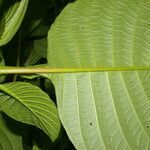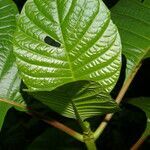Trees 5-8 m tall, the branchlets angular, glabrous, drying gray or reddish gray. Leaves oblong rotund to ovate rotund, to 30 cm long, to 20 cm wide, widely deltoid at the apex, obtuse to subrotund at the base, the costa slender, promi-nulous above and beneath, the lateral veins slender, 12-13, arcuate, the basal lateral veins often leaving the costa at right angles, the smaller veins pinnatiform, stiffly chartaceous, scarcely discolorous, drying red, glabrate above, appressed pilose oft the costa and the lateral veins beneath; petioles to 8 cm long; stipules not seen. Inflorescences paniculate, to 35 cm long, the branches opposite, angular ascending, the lowermost to 15 cm long. Flowers not seen. Fruits pedicellate, the pedicels short, the capsules narrowly oblong or narrowly ovate oblong, to 3.5 cm long, to 0.7 cm wide, minutely golden puberulent, delicately longitudinally ribbed, the persistent calyx 1-2 mm long, wider than the apex of the capsule.
A deciduous tree. It grows 10-30 m tall. The small branches are thick and hairy. The leaf blades are broadly oval. They are 45 cm long by 15 cm wide. They are thin textures and hairy on both sides. The flowering arrangement is 25 cm long. There are many flowers. They are pink or red. The fruit are capsules 2.5 cm long and are twice as long as wide.
Leaf-blades more rounded, 9–50 cm. long, 7–35 cm. wide, pubescent to glabrescent beneath.. Corolla tinged pink or red with tube 1.1–1.4 cm. long.. Capsule elongate.



